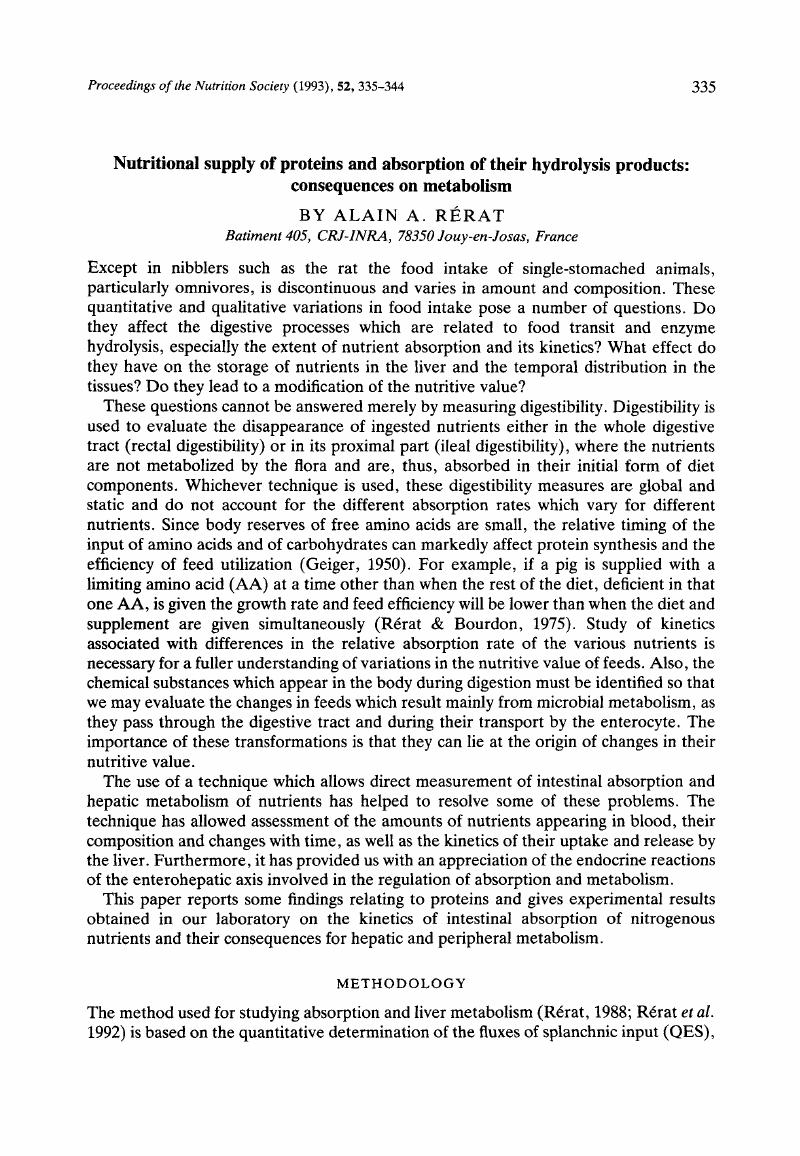Crossref Citations
This article has been cited by the following publications. This list is generated based on data provided by Crossref.
Berge, Gerd Eikeland
Lied, Einar
and
Sveier, Harald
1997.
Nutrition of Atlantic Salmon (Salmo salar): The Requirement and Metabolism of Arginine.
Comparative Biochemistry and Physiology Part A: Physiology,
Vol. 117,
Issue. 4,
p.
501.
Lang, V
Bellisle, F
Oppert, JM
Craplet, C
Bornet, FR
Slama, G
and
Guy-Grand, B
1998.
Satiating effect of proteins in healthy subjects: a comparison of egg albumin, casein, gelatin, soy protein, pea protein, and wheat gluten.
The American Journal of Clinical Nutrition,
Vol. 67,
Issue. 6,
p.
1197.
Rønnestad, Ivar
Conceição, Luis E.C.
Aragão, Claudia
and
Dinis, Maria T.
2000.
Free Amino Acids Are Absorbed Faster and Assimilated More Efficiently than Protein in Postlarval Senegal Sole (Solea senegalensis).
The Journal of Nutrition,
Vol. 130,
Issue. 11,
p.
2809.
Yen, Jong-Tseng
2000.
Swine Nutrition, Second Edition.
Mosoni, Laurent
and
Mirand, Philippe Patureau
2003.
Type and timing of protein feeding to optimize anabolism.
Current Opinion in Clinical Nutrition & Metabolic Care,
Vol. 6,
Issue. 3,
p.
301.
Mosoni, Laurent
and
Mirand, Philippe
2003.
Current Opinion in Clinical Nutrition & Metabolic Care,
Vol. 6,
Issue. 3,
p.
301.
Zhanghi, Brian M.
and
Matthews, James C.
2008.
Protein Hydrolysates in Biotechnology.
p.
135.
Jahan-Mihan, Alireza
Luhovyy, Bohdan L.
El Khoury, Dalia
and
Anderson, G. Harvey
2011.
Dietary Proteins as Determinants of Metabolic and Physiologic Functions of the Gastrointestinal Tract.
Nutrients,
Vol. 3,
Issue. 5,
p.
574.
Silvestre, Marialice P.C.
Silva, Maite C.
Silva, Viviane D.M.
Silva, Mauro R.
and
Amorin, Larissa L.
2011.
WPC Hydrolysates Obtained by the Action of a Pancreatin: Preparation, Analysis and Phenylalanine Removal.
Asian Journal of Scientific Research,
Vol. 4,
Issue. 4,
p.
302.
Coelho Sil, Marialice Pinto
Oliveira A, Wendel de
Lopes Juni, Carlos de Oliveira
Medeiros S, Viviane Dias
Morais, Harriman Aley
de Souza, Mariana Wanessa Sant
and
Silva, Mauro Ramalho
2011.
Use of Subtilisin and Pancretin for Hydrolyzing Whey Protein Concentrate.
American Journal of Food Technology,
Vol. 6,
Issue. 8,
p.
647.
Silvestre, Marialice Pinto Coelho
Morais, Harriman Aley
Silva, Mauro Ramalho
de Souza, Mariana Wanessa Santana
and
Silva, Viviane Dias Medeiros
2012.
Preparation and analysis of hydrolysates from whey protein concentrate using the proteases from Bacillus licheniformis and Aspergillus oryzae.
International Journal of Food Science & Technology,
Vol. 47,
Issue. 7,
p.
1532.
Clausen, Morten Rahr
Zhang, Xumin
Yde, Christian C.
Ditlev, Ditte B.
Lillefosse, Haldis H.
Madsen, Lise
Kristiansen, Karsten
Liaset, Bjørn
Bertram, Hanne C.
and
Moschetta, Antonio
2015.
Intake of Hydrolyzed Casein is Associated with Reduced Body Fat Accretion and Enhanced Phase II Metabolism in Obesity Prone C57BL/6J Mice.
PLOS ONE,
Vol. 10,
Issue. 3,
p.
e0118895.
Liu, S.Y.
and
Selle, P.H.
2015.
A consideration of starch and protein digestive dynamics in chicken-meat production.
World's Poultry Science Journal,
Vol. 71,
Issue. 2,
p.
297.
Truong, Ha H.
Liu, Sonia Y.
and
Selle, Peter H.
2016.
Starch utilisation in chicken-meat production: the foremost influential factors.
Animal Production Science,
Vol. 56,
Issue. 5,
p.
797.
Lachica, Manuel
Rodríguez-López, Jose Miguel
González-Valero, Lucrecia
and
Fernández-Fígares, Ignacio
2018.
Iberian pig adaptation to acorn consumption: II. Net portal appearance of amino acids.
PeerJ,
Vol. 6,
Issue. ,
p.
e6137.
Selle, PeterH.
and
Liu, Sonia Yun
2019.
The Relevance of Starch and Protein Digestive Dynamics in Poultry.
Journal of Applied Poultry Research,
Vol. 28,
Issue. 3,
p.
531.
Lachica, M.
González-Valero, L.
Rodríguez-López, J. M.
Lara, L.
and
Fernández-Fígares, I.
2019.
Portal drained-viscera heat production and net flux of volatile fatty acids in Iberian pigs fed acorn.
Animal Production Science,
Vol. 59,
Issue. 8,
p.
1470.
Nørgaard, Jan V.
Florescu, Iulia C.
Krogh, Uffe
and
Nielsen, Tina Skau
2021.
Amino Acid Absorption Profiles in Growing Pigs Fed Different Protein Sources.
Animals,
Vol. 11,
Issue. 6,
p.
1740.
Macelline, Shemil P.
Chrystal, Peter V.
Liu, Sonia Y.
and
Selle, Peter H.
2021.
The Dynamic Conversion of Dietary Protein and Amino Acids into Chicken-Meat Protein.
Animals,
Vol. 11,
Issue. 8,
p.
2288.
Lachica, M.
Rojas-Cano, M.L.
Lara, L.
Haro, A.
and
Fernández-Fígares, I.
2021.
Net portal appearance of proteinogenic amino acids in Iberian pigs fed betaine and conjugated linoleic acid supplemented diets.
Animal Feed Science and Technology,
Vol. 273,
Issue. ,
p.
114825.



